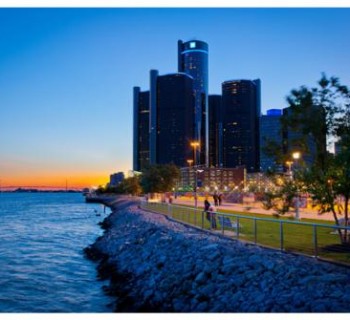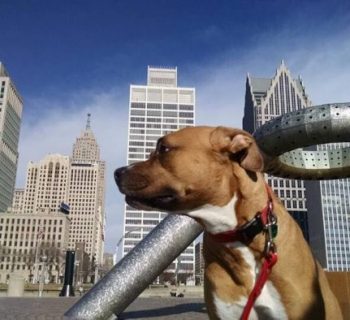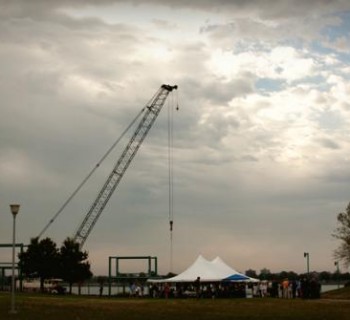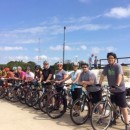Detroit is a great place to ride a bicycle. From Belle Isle to Palmer Woods, Corktown to the West Village, or Brightmoor to Southwest, Detroit provides plenty of sights for bicyclists that people just can’t experience in vehicles. However, Detroit also offers a range of obstacles for bicyclists, regardless of whether they are recreational riders, or die-hard commuters. We’ve gathered some suggestions for bicyclists who are new to riding in the city of Detroit, so that your next ride…can be a pleasant ride.
1. Conduct Yourself Like A Motorist
First and foremost: don’t run red lights! Running reds is a habit that many motorists in Detroit have adopted. You don’t want to find yourself on the pavement simply because you, too, failed to neglect the rules of the road.
Secondly, stay off sidewalks! Detroit’s roads are filled with bike lanes and, even when no bike lanes are present, it is simply safer to ride on the road. When riding on sidewalks, especially at night, it’s possible to hit pedestrians or be hit by cars coming out of alleys or driveways.
Finally, always go with the flow of traffic. Imagine yourself driving down Woodward and seeing a bicyclist coming at you while you’re merging into the right lane. A lot of cyclists assume that it’s okay to go the opposite way on streets like Forest, Warren, or even Jefferson simply because they are bicyclists and not motorists. However, this is extremely dangerous. The key to being safe while riding your bike in Detroit is predictability. For these reasons, conducting yourself like a car whenever you’re on the road is always the best plan.
2. Take Advantage Of Routes With Bike Lanes
Detroit’s bike lanes have been expanding in the last few years at an exponential rate. Especially if you live in Midtown, there are a variety of alternative routes with bike lanes. On these alternative routes, you can ride much more safely than on car-heavy roads like Woodward Avenue or Martin Luther King, Jr. Boulevard. If traveling north through Midtown, instead of Woodward, think about taking 3rd Street. 3rd St. and 2nd Ave. in Midtown have had dedicated bike lanes since the Summer 2012.
Instead of venturing through downtown if traveling at night, consider using the Dequindre Cut, a bicycle path that extends from Atwater St. to Gratiot Ave. (with plans for it to expand to Mack Ave.). Once the Cut expands to Mack Ave., it will be possible to travel from Woodbridge to Chene Park almost exclusively on dedicated bicycle lanes.
3. Put Battery-Powered Lights On Your Bike
Always keep working lights on the front and rear of your bicycle. Especially if your primary form of transportation is your bicycle, you don’t want to find yourself in pitch-black darkness while coming back home from the bar. Motorists in Detroit are not used to spotting bicyclists at night, so don’t skirt an easy way to maintain visibility at night. While a bright front light alerts others to your position on the road, it will also help you avoid potholes and shards of glass that may ruin your ride.
In addition to lights, an old-fashioned bell can work wonders. Passing a group of pedestrians on the RiverWalk? Ring ring. Is the motorist in front of you unaware that the light has turned green? Ring ring. A bell is a great way to get the attention of others while still maintaining common courtesy.
4. Carry A Seat Bag And Compact Bike Pump
Carry a small seat kit with you at all times! The supplies you need are very limited but can be the difference between minor setback and terrible day. The essential contents of any seat bag include an extra tube, tire levers, a set of allen wrenches, and a small adjustable crescent wrench.
The extra tube is necessary in case one of your bicycle’s tires runs over one of Detroit’s many potholes. This is especially important for those riding bikes with skinny tires. Tire levers are necessary to pull the tire off of the wheel, so don’t forget one of those. A set of allen wrenches (metric or standard, as required for your bike) is a great companion in case you need to tighten your seat post or adjust your handlebars. Another tool, the adjustable crescent wrench, can be useful for any number of minor adjustments, including your seat. Just make sure you have the right size!
Outside of the essentials in your seat bag, a crucial tool for any bicyclist is a frame pump. Imagine carrying an extra tube and tire levers without being able to inflate your tire after changing it! Whether it’s an air pump or carbon-dioxide pump, a frame pump will get you home if and when you get a flat. Additionally, a frame pump can be helpful for friends you’re riding with if they don’t have one and get a flat.
5. Always Use A Lock
In Detroit, as in other cities, a stolen bicycle is something every cyclist wants to avoid. What’s worse than riding to school or work and coming back only to find your bicycle stolen? Unfortunately, this isn’t the only possibility. Does anyone remember the Midtown and Woodbridge bicycle thief who only stole front tires?
A U-Lock or chain lock ensures that your bicycle is kept safe while you’re away. Locks are best used when they are secured around the back of the front tire, the frame of the bicycle between the top tube and down tube, and an immovable object. Stronger than a chain lock, and easy to carry on your seat post, a U-Lock is easy to use and hard to forget at home. Just make sure you don’t lose the key! #bikeability #detroit #neighborhoods









